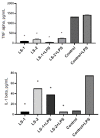Immunomodulatory Effects of Plant Extracts from Salvia deserta Schang. and Salvia sclarea L
- PMID: 36297710
- PMCID: PMC9610708
- DOI: 10.3390/plants11202690
Immunomodulatory Effects of Plant Extracts from Salvia deserta Schang. and Salvia sclarea L
Abstract
Medicines, their safety, effectiveness and quality are indispensable factors of national security, important on a global scale. The COVID-19 pandemic has once again emphasized the importance of improving the immune response of the body in the face of severe viral infections. Plants from the Salvia L. genus have long been used in traditional medicine for treatment of inflammatory processes, parasitic diseases, bacterial and viral infections. The aim of the current study was to evaluate the immunomodulatory effects of plant extracts LS-1, LS-2 from Salvia deserta Schang. and LS-3, LS-4 from Salvia sclarea L. plants growing in southern Kazakhstan by conventional and ultrasonic-assisted extraction, respectively. The cytotoxic effects of the named sage extracts on neonatal human dermal fibroblasts (HDFn) were evaluated using the MTT assay. Immunomodulatory effects of the studied extracts were compared by examining their influence on pro-inflammatory cytokine secretion and phagocytic activity of murine immune cells. Depending on the physiological state of the innate immune cells, sage extracts LS-2 and LS-3 had either a stimulating effect on inactivated macrophages or suppressed cytokine-producing activity in LPS-activated macrophages. The greatest increase in TNF-α secretion was found after treatment of spleen T lymphocytes with sage extract LS-2, obtained by ultrasonic-assisted extraction.
Keywords: conventional extraction; immunomodulatory; sage; ultrasonic-assisted extraction.
Conflict of interest statement
The authors declare no conflict of interest.
Figures












Similar articles
-
Anti-inflammatory effect of the Salvia sclarea L. ethanolic extract on lipopolysaccharide-induced periodontitis in rats.J Ethnopharmacol. 2017 Mar 6;199:52-59. doi: 10.1016/j.jep.2017.01.020. Epub 2017 Jan 16. J Ethnopharmacol. 2017. PMID: 28093319
-
New insights into the in vitro biological effects, in silico docking and chemical profile of clary sage - Salvia sclarea L.Comput Biol Chem. 2018 Aug;75:111-119. doi: 10.1016/j.compbiolchem.2018.05.005. Epub 2018 May 6. Comput Biol Chem. 2018. PMID: 29772456
-
Kinetics of ultrasonic extraction of extractive substances from garden (Salvia officinalis L.) and glutinous (Salvia glutinosa L.) sage.Ultrason Sonochem. 2006 Feb;13(2):150-6. doi: 10.1016/j.ultsonch.2005.02.002. Epub 2005 Apr 7. Ultrason Sonochem. 2006. PMID: 16293523
-
Current State of the Art on the Antioxidant Activity of Sage (Salvia spp.) and Its Bioactive Components.Planta Med. 2020 Mar;86(4):224-238. doi: 10.1055/a-1087-8276. Epub 2020 Jan 23. Planta Med. 2020. PMID: 31975363 Review.
-
Current Advances on the Extraction and Identification of Bioactive Components of Sage (Salvia spp.).Curr Pharm Biotechnol. 2019;20(10):845-857. doi: 10.2174/1389201020666190722130440. Curr Pharm Biotechnol. 2019. PMID: 31333123 Review.
Cited by
-
Molecular docking analysis of Salvia sclarea flower extracts evaluated for protein target affinity based on different extraction methods.Food Sci Nutr. 2024 Sep 15;12(11):8990-9006. doi: 10.1002/fsn3.4467. eCollection 2024 Nov. Food Sci Nutr. 2024. PMID: 39619984 Free PMC article.
-
A Review of Botany, Phytochemistry, and Biological Activities of Eight Salvia Species Widespread in Kazakhstan.Molecules. 2025 Mar 3;30(5):1142. doi: 10.3390/molecules30051142. Molecules. 2025. PMID: 40076365 Free PMC article. Review.
-
[Inhibitory Activity of Flower Extracts from Salvia deserta Schang on Streptococcus mutans].Sichuan Da Xue Xue Bao Yi Xue Ban. 2023 May;54(3):539-544. doi: 10.12182/20230560211. Sichuan Da Xue Xue Bao Yi Xue Ban. 2023. PMID: 37248581 Free PMC article. Chinese.
-
Exploring the Chemical Composition and Antimicrobial Activity of Extracts from the Roots and Aboveground Parts of Limonium gmelini.Molecules. 2025 Jul 18;30(14):3024. doi: 10.3390/molecules30143024. Molecules. 2025. PMID: 40733291 Free PMC article.
-
Natural Compounds of Salvia L. Genus and Molecular Mechanism of Their Biological Activity.Biomedicines. 2023 Nov 27;11(12):3151. doi: 10.3390/biomedicines11123151. Biomedicines. 2023. PMID: 38137372 Free PMC article. Review.
References
-
- Muyumba N.W., Mutombo S.C., Sheridan H., Nachtergael A., Duez P. Quality control of herbal drugs and preparations: The methods of analysis, their relevance and applications. Talanta Open. 2021;4:100070. doi: 10.1016/j.talo.2021.100070. - DOI
-
- Sarsenbayev K.N. Chapter 10. Medicinally important plants of Kazakhstan. In: Egamberdieva D., Öztürk M., editors. Vegetation of Central Asia and Environs. Springer; Cham, Switzerland: 2018. p. 264.
-
- Zhusupova G.E., Litvinenko Y.A., Zhussupova A.I. Methodology for Processing Medicinal Plant Materials. Qazaq University Press; Almaty, Kazakhstan: 2018. 150p
-
- Aleksovski A., Sovova H. Supercritical CO2 extraction of Salvia officinalis L. J. Supercrit. Fluids. 2007;40:239–245. doi: 10.1016/j.supflu.2006.07.006. - DOI
Grants and funding
LinkOut - more resources
Full Text Sources

